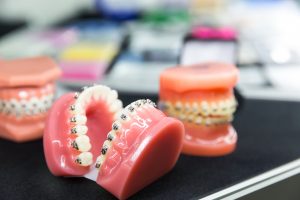Orthodontics
Understanding Orthodontics

Orthodontic dentistry is as important as every other dentistry concept. It allows for the correction of the jaw or teeth that are not properly aligned.
While misaligned oral anatomy may seem like a cosmetic issue, it can dramatically affect oral health. Misaligned teeth are difficult to keep clean, which increases the risk of patients developing cavities and gum disease. It also makes chewing difficult when surfaces do not align, which can lead to difficulty eating, speaking, and even jaw pain over time.
Just like there are a lot of reasons to have orthodontic care, there are a number of approaches that can be customized to treat individual cases. The treatment options include fixed appliances and removable appliances.
A fixed appliance is a small metal or ceramic bracket that is specially placed on your teeth to help straighten them. Metal braces are the most common. Braces consist of bands, wires and/or brackets that are bonded on the front surface of your teeth. Bands are fixed around the teeth or tooth and used as anchors for the appliance. The brackets are bonded to the front of the teeth and an archwire is passed through the brackets and attached to the bands. By tightening the archwire, it puts tension on the teeth, which will gradually move the teeth to their proper position. Braces are usually adjusted monthly to bring about the desired results, which may be achieved within a few months to a few years depending on the severity of the patient’s teeth. They can come in bright colors for kids, as well as clear styles preferred by many adults.
A removable appliance is a clear plastic tray that is specially made just for your teeth. Unlike metal braces, the plastic trays need to be removed in order to eat, brush your teeth, and floss. The dentist will take impressions of your teeth and a mold is created and sent to the lab where the design of your clear trays will begin. The trays are made to fit your teeth perfectly, and as your teeth move and adjust so will the aligners. The dentist will change out the aligners to keep your teeth moving in the direction he wants.
Common Conditions Treated with Orthodontic Care
There are a number of common conditions treated through the use of orthodontic care, including:
- Overbite – the front teeth overlap the bottom teeth.
- Underbite – the bottom teeth overlap the top teeth.
- Crossbite – when the upper teeth do not descend directly in front of the lower teeth.
- Openbite – space between the chewing surface of the teeth when the jaw is closed.
- Misplaced Midline – when the center of the upper front teeth does not align with the center of the lower teeth.
- Spacing – unexpected gaps or spaces between teeth.
- Crowded Teeth – Teeth pushed too tightly together, or overlapping teeth.

